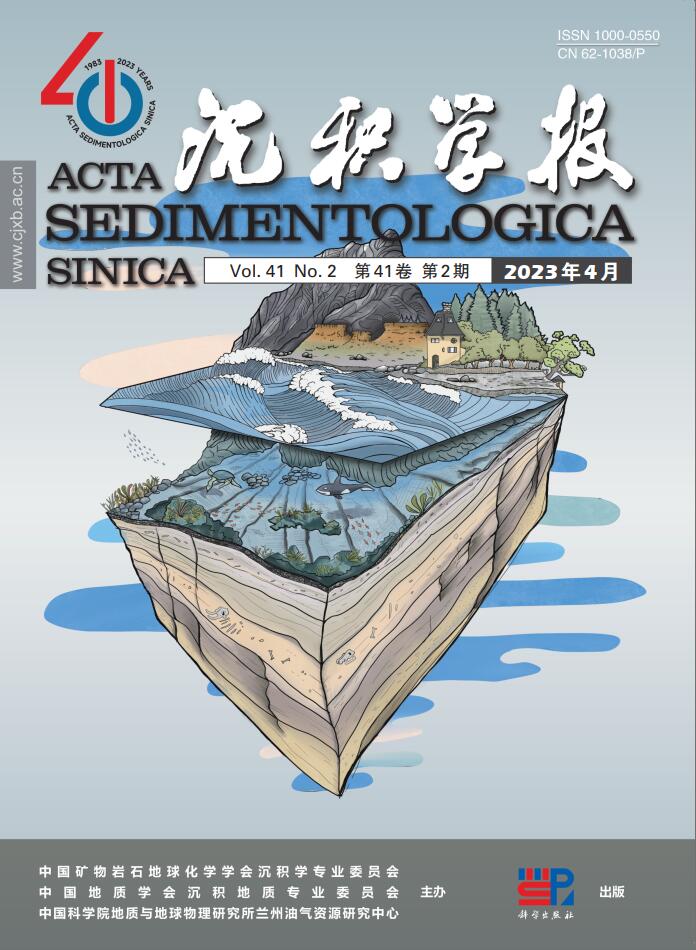HTML
-
我国的蒸发盐矿普遍规模小,且多分布在西部地区,东部较少,但是古近纪时期,鲁东地区发育聚煤盆地[1],而鲁西南地区则发育一系列蒸发盐矿床[2]。古近纪是山东省盐岩成矿主要的三个时期之一,已发现的含盐盆地为大汶口盆地、平邑盆地、枣庄盆地等,盆地内沉积序列均以湖相为主,沉积序列组合在盆地边缘上沉积厚度较薄[3]。由于煤矿和盐岩形成的气候条件截然不同,表明古近纪时期山东具有复杂的古气候和古地理格局。古近纪时期鲁西南和鲁东地区的各个盆地均受控于郯庐断裂,盆地的断裂构造为盐类矿床的形成提供了有利的成矿地质条件,构造裂隙也为成矿物质的运移提供了通道,而干旱气候则是盐类矿床形成所必需的气候条件。
单县盆地盐矿为山东省地质勘察队在鲁西南地区新发现的盐类矿床,据初步勘察,其盐储量达到百亿吨,是典型的小陆块盆地形成的大型盐类矿床。盆地内的沉积物能够记录大量的古气候古环境演变信息,是研究成矿地区古湖泊演化模式的重要载体。单县盆地在始新世中晚期—渐新世形成了巨厚的蒸发盐层,但其成盐期的古气候古环境研究较少。湖泊沉积物元素地球化学含量的变化可敏感反映湖泊沉积环境的变化过程[4],碳酸盐的碳氧同位素组成作为湖泊环境变化的一项指标,也早已被用于湖泊研究中以解释古环境变化[5⁃8]。基于此,本文利用单县盆地边缘的YZK-3钻孔(34°81′ N,116°12′ E,长约520 m)岩心样品,在矿物学研究基础上,开展湖泊沉积物元素地球化学和碳酸盐碳氧稳定同位素测试分析,探讨古近纪时期单县盆地古湖泊的古环境演化历程和相应的古气候条件。
-
鲁西南单县盆地位于华北板块东南缘,形成于白垩纪晚期,受控于郯庐断裂[2,9⁃10]。郯庐断裂的演化对鲁西南地区盆地的形成产生了重要影响[11⁃12]。晚侏罗世—始新世,郯庐断裂以左旋剪切活动为主转变为右旋剪切活动为主,导致鲁西南地区发育不同方向的断层,如NW、EW、NE向断层[11]。华北成盐区是中国东部中新生代主要成盐区,鲁西南地区归属于华北成盐区,据刘群等[2],其成盐时代为始新世中晚期—渐新世。另外,根据岩心特征和地层对比[12]以及内部资料,钻孔层位为管庄群的大汶口组。因此,初步推断单县盆地YZK-3钻孔的年代最大范围为始新世—渐新世。始新世中晚期—渐新世早期,鲁西南地区各个盆地沉积演化大体相似,均由淡水湖或半咸水湖逐渐演变为咸水湖[3],演化过程中可能受海侵影响[12],但单县盆地石盐和硬石膏的锶同位素及沉积学特征均未识别到海水信息1。渐新世中期,断裂活动停止,盆地不断被碎屑物质充填[3]。鲁西南单县盆地位于黄泛冲积平原,目前被第四纪松散堆积物所覆盖(图1)。

Figure 1. Geographic location of borehole YZK⁃3 in the Shanxian Basin (modified from Diao et al.[3])
-
YZK-3钻孔岩性变化:钻孔底部向上至1 099.98 m为砂岩层与泥岩层交替出现,含少数蒸发盐层(研究区主要是石膏和石盐层);1 099.98~861.88 m均为泥岩层与蒸发盐层交替,泥岩大部分呈薄层状;861.88 m至钻孔顶部重新演变为泥岩层与砂岩层交替出现,部分砂岩呈团块状或团粒状,且在861.88~712.38 m之间多数层位有纹层。钻孔中的碎屑矿物主要是石英、长石、黏土矿物和云母,非碎屑矿物主要是碳酸盐、石膏、硬石膏以及少量石盐。碳酸盐矿物有方解石、铁白云石、少量文石和微量白云石,总碳酸盐含量为2%~82%,最高值出现在843.38 m处。根据矿物种类和含量分布以及沉积物沉积特征,将单县盆地古湖泊演化分为六个阶段,对照深度为阶段Ⅰ(1 157.08~1 153.38 m)、阶段Ⅱ(1 153.38~965.18 m)、阶段Ⅲ(965.18~961.5 m)、阶段Ⅳ(961.5~862.88 m)、阶段Ⅴ(862.88~733.38 m)、阶段Ⅵ(733.38~635.38 m)(图2)。
1.1. 地质背景
1.2. YZK⁃3钻孔特征
-
根据岩性变化,按照2~3 m间隔,挑选样品,研磨至200目左右,分别进行元素和碳酸盐碳氧同位素的测试,元素分析样品242个,全样碳酸盐碳氧同位素测试145个,4个样品过400目筛网(孔径38 µm),做碳氧同位素的对比分析。前处理及分析程序如下。
元素测试分析:1)水溶,称取0.5~0.8 g样品(准确记录)放入离心管中,加入10 mL超纯水,充分摇晃后静置12 h,离心,取上层清液3 mL,并加10 mL超纯水定容;2)酸溶,倒掉水溶样品的剩余上层液体,加入超纯水10 mL,振荡,离心,倒掉上层液体,重复三次,清洗掉水溶组分,加入醋酸(1 mol/L,1∶9)10 mL,超声2 h,离心(3 000 r,>20 min),取上层清液1 mL,加入10 mL超纯水定容。元素测试在中国科学院青藏高原研究所大陆碰撞与高原隆升实验室完成,使用仪器为美国Leeman公司生产的电感耦合光谱仪器(ICP-OES)。
碳氧同位素:称量约100 μg样品,放入12 mL反应瓶中,通入高纯度氦气(99.999%,流速100 mL/min),持续600 s排空处理;加5滴100%无水磷酸,在72 ℃加热盘中反应和平衡大于4 h。反应达到平衡后,CO2气体通过70 ℃熔硅毛细管柱(Poraplot Q,25 m×0.32 mm),与其他杂质气体分离后进行碳氧同位素的测试。该实验在国土资源部成矿作用与资源评价重点实验室完成,使用仪器为MAT253质谱仪。
-
水溶组分元素Ca、Mg、Sr、Na和K的含量及变化见图3和表1。各元素的平均含量由大到小为Na>Ca>K>Mg>Sr。Na、Ca和Sr的变化趋势比较明显,总体较为一致。Na含量由钻孔底部至顶部先升高后降低,最高值位于盐湖阶段。Ca和Sr含量在淡水和咸水湖阶段的趋势与Na较为一致,但在盐湖阶段没有出现峰值。Mg和K的曲线没有明显的变化趋势。易溶盐离子总量(total)变化趋势与Na较为一致。Mg/Ca摩尔比仅在底部和750~800 m之间出现峰值,与沉积环境的变化没有关系,Sr/Ca摩尔比值在咸水湖环境中偶尔出现几个峰值。
元素 最大值/(mg/g) 最小值/(mg/g) 平均值/(mg/g) Ca 16.30 0.006 3.80 Mg 2.54 0.000 3 0.33 Sr 0.39 0.000 3 0.08 K 3.04 0.008 0.47 Na 19.71 0.02 6.28 酸溶元素Ca、Mg、Sr和Fe含量分别为0.64~348.28 mg/g、0.25~69.44 mg/g、0.01~10.85 mg/g和0.02~3.33 mg/g,平均值分别为94.9 mg/g、8.57 mg/g、0.88 mg/g和0.71 mg/g(图4)。Ca为酸溶组分的主要元素,由于沉积物中出现多种碳酸盐矿物,Ca与常见的类质同象替代元素Mg、Sr等元素曲线之间,没有相似的变化趋势。Ca、Mg、Fe和Sr含量总和与碳酸盐含量呈显著正相关(图5,R2=0.789 17),说明这些元素主要来源于碳酸盐矿物。
-
全样碳酸盐的δ18O和δ13C多为负值,δ18O值介于-13.1‰~2.9‰,平均值为-6.78‰,最大变幅为10.2‰;δ13C介于-10.2‰~2.3‰,平均值为-6.37‰,最大变幅为6.7‰。碳氧同位素与总碳酸盐含量具有相似的变化趋势(图6)。阶段Ⅰ(1 157.08~1 153.38 m),δ18O和δ13C值较低,平均值分别为-7.3‰和-5.25‰;阶段Ⅱ(1 153.38~965.18 m),δ18O和δ13C值虽然较上一阶段偏正,但钻孔中δ18O最低值出现在该阶段;阶段Ⅲ(965.18~961.5 m),δ18O均为正值,δ13C值延续上阶段的波动,但波动幅度小;阶段Ⅳ(961.5~862.88 m),δ18O和δ13C变化较大,存在明显负漂;阶段Ⅴ(862.88~733.38 m),δ18O波动幅度降低,δ13C与上一阶段呈反向波动;阶段Ⅵ(733.38~635.38 m),δ18O和δ13C值均大幅降低,平均值分别为-6.02‰和-5.33‰,钻孔中δ13C最低值出现在该阶段。虽然碳氧同位素基本呈同步变化,但波动频繁且幅度较大。
细颗粒(<38 μm)碳酸盐碳氧同位素如表2。一般认为,粒径小于38 μm的碳酸盐矿物是自生的[13],自生碳酸盐碳氧同位素比全样数据偏正,但钻孔中的这四个细颗粒样品与全样碳酸盐的值相比,只有一个细颗粒样品比全样的值偏正(963.38 m,盐湖阶段),另外三个的均值比全样偏负(表2、图7)。
深度/m δ18O全样/‰ δ13C全样/‰ δ18O细颗粒/‰ δ13C细颗粒/‰ 699.38 -5.3 -4.5 -5.7 -4.2 881.38 -3.9 -2.2 -4.2 -2.3 963.38 0.8 -2.7 0.9 -2.1 1 155.38 -7.3 -7.0 -7.7 -7.0
3.1. 元素
3.2. 碳氧同位素
-
钻孔中碳酸盐矿物主要是方解石和铁白云石,还有少量文石和白云石。一般认为,湖泊沉积物中方解石有三种来源:化学沉积(包括自生的、成岩作用期析出的)、碎屑来源以及生物来源,化学沉积是方解石的主要成因,碎屑和生物方解石的含量较少[13⁃16]。湖泊沉积物中,生物成因方解石主要来源于生物壳,如介形虫壳,而湖泊沉积物中生物壳的重量仅几个微克,不足以影响全样方解石的含量[14,16]。
碎屑矿物石英与方解石含量之间的关系可以佐证方解石的成因。石英和方解石在不同盐度的湖泊中相关性明显不同(图8a),淡水湖阶段,二者相关性较高(R2=0.51),而咸水湖和盐湖阶段,二者基本不相关(R2=0.07)。淡水湖阶段碎屑来源的方解石含量不可忽视,而咸水湖和盐湖阶段方解石以化学沉淀为主,碎屑来源的较少。无论湖泊处于哪个阶段、无论方解石是哪种来源,酸溶组分Ca与方解石含量之间均呈明显的正相关关系(图8b),说明沉积物中碳酸盐矿物以方解石为主。
文石一般出现在咸水湖和盐湖环境中[15],为不稳定矿物,湖泊沉积物中的文石可直接认定为自生矿物。高Mg/Ca摩尔比为文石析出的条件之一[17],高Mg2+能有效阻止方解石晶体的生长,使文石优先生长[18],但Mg2+难以进入文石晶格。与Mg2+不同,Sr2+易进入文石晶体,或是与有机质结合而促进文石晶体的生长[19]。钻孔中文石含量高的层位Sr也更加富集(图2,4),文石与Sr有较好的相关性(R2=0.4),而Sr与方解石之间基本不存在相关性(图8c)。
钻孔中白云石可能来源于自生、成岩作用以及碎屑物质。咸水和盐湖阶段的白云石可能存在自生成因,淡水环境下的白云石可能来源于岩石风化的碎屑物质,而成岩作用形成的白云石在不同盐度湖泊中均可发生。作为蒸发碳酸盐矿物的一种,Mg/Ca摩尔比大于12可能有白云石析出,但无机环境下,即使溶液达到过饱和状态,白云石也难以直接沉淀[20],微生物的介导作用被认为是白云石形成的关键[21]。高浓度的Mg2+在微生物的介导作用下克服动力学障碍,进入碳酸钙晶格形成白云石[20]。成岩作用过程中,也能形成一定数量的白云石[22]。铁白云石Ca(Mg,Fe)(CO3)2是白云石的一种,由Fe2+置换白云石中的Mg2+而形成,Fe2+主要来源于热液和黏土矿物[23⁃25]。研究区单县盆地周围断裂极其发育,这些构造背景均有利于深部热液的补给2。Fe2+进入白云石晶格一般发生在高温和还原环境中[26],沉积物的温度随着埋藏深度的增加而升高,加之热液流体从地球深部向上进入盆地,因此,深部沉积物的温度高。这可以解释YZK-3钻孔中下部铁白云石含量高,顶部铁白云石消失的原因。热液流体的间歇性运移可能是铁白云石含量波动的原因之一[27]。
-
Ca、Mg、Na、K是湖水主要的阳离子,其含量高低与气候干湿变化有关,干旱气候条件下,蒸发作用强,湖水浓缩,离子含量高,反之亦然。Mg/Ca摩尔比是影响碳酸盐矿物析出的重要因素之一,高Mg/Ca摩尔比是文石、白云石矿物析出的条件之一,指示矿物形成时的湖水盐度;碳酸盐矿物析出过程中,一般有微生物的参与,所以,水溶和酸溶的Mg/Ca比值不完全一致(图3,4)。Sr是碳酸盐矿物中常见的类质同象替代元素,Sr/(Ca+Mg)比和Mg/Ca比也均与湖水盐度有关,比值会因湖水浓缩而增大[28](图8d)。Na为非生物元素,一般不进入碳酸盐矿物晶格,因此,对湖水盐度变化非常敏感。Na离子含量的高低,直接指示湖水盐度的高低。虽然K离子与Na离子类似,但K离子含量低,在盐度指示方面不如Na离子敏感。
碳酸盐含量的高低也可以反映湖水的咸化和淡化,以及气候的干湿变化。相对湿润气候条件下,蒸发作用弱,湖面高,湖水淡化,碳酸盐含量较低;气候干旱时,蒸发作用强,湖面低,湖水咸化,碳酸盐含量增高。气候干旱,蒸发作用强,湖水浓缩,碳酸盐析出,反之亦然[29⁃32]。
自生碳酸盐δ18O和δ13C的变化也是常用的古环境指标之一。干旱地区,蒸发作用强烈,湖水中较轻16O优先发生逸散,因此,蒸发量/降水量(P/E比)值较高时会造成湖水中18O较多、较富集的现象。碳酸盐δ13C值的变化主要取决于湖水TDIC(总溶解无机碳)的同位素组成[7,33]。当蒸发作用增强,富12C的CO2优先向大气扩散,且由于湖水浓缩,盐度升高,对应碳同位素值高[34]。因此,蒸发作用增强,碳氧同位素表现为同步偏重,相反为同步偏轻。
δ18O和δ13C的相关性可判断湖泊的封闭程度[5,8,35]。在开放型淡水湖泊中,自生碳酸盐δ18O和δ13C之间不相关或呈略相关,且两者均为负值;在封闭型咸水和封闭型半咸水湖泊中,两者有明显的相关性,且随着湖泊封闭程度增加其相关性增强,δ18O正负均有,δ13C基本为正值[5]。在现代湖泊中,根据碳酸盐的δ13C值也可以大致判断湖泊类型,其中碳酸盐的δ13C值在-12‰~-6‰之间为淡水湖,在咸水湖中能达到+5‰,在超咸水湖中可高达+13‰[36]。
-
YZK-3钻孔沉积物碳酸盐δ18O和δ13C绝大部分数据点落在了第三、四象限,个别在第二象限(图9)。与世界不同盐度湖泊的对比发现,阶段Ⅰ、Ⅵ(淡水湖)数据点全部落在第三象限,位于开放淡水湖泊范围内或靠近此区域,其他数据大部分位于咸水湖和盐湖区域。δ18O和δ13C相关性不高(R2=0.12),原因可能是盆地存在大量热液补给。热液矿物铁白云石含量高达73%3,因此,YZK-3钻孔δ18O和δ13C的相关性不适合讨论湖泊的封闭与开放状态。

Figure 9. Comparison of carbon and oxygen isotopes for carbonates in borehole YZK⁃3 and various modern lakes (modified from Talbot[5])
全样和细颗粒(<38 μm)碳酸盐碳氧同位素的值相差不大(图7),演化趋势基本一致。细颗粒碳酸盐可能以湖泊自生碳酸盐为主,记录了湖水性质和成岩作用中热液作用的影响,而全样碳酸盐包括岩石风化的产物(即地表岩石的化学风化作用)。因此,全样的碳酸盐同位素数据记录了更全面的气候环境信息,可以用于讨论古环境演化。
基于矿物学的变化,中始新世—渐新世的湖泊演化被分为6个阶段,湖泊经历了淡水湖、咸水湖、盐湖、咸水湖、淡水湖的演变过程(图2)。Na等可溶元素含量和碳酸盐含量及碳酸盐同位素的变化指示了淡水湖、咸水湖和盐湖的变化(图3,4,6),与矿物的变化基本一致,即淡水湖环境下,Ca、Mg、Sr、Na等元素的含量和碳酸盐的含量都较低,咸水湖和盐湖环境下含量升高,但也有差异(图3,6)。如,无论淡水湖阶段还是咸水湖、盐湖阶段,钻孔中δ13C明显偏负,钻孔底部和顶部,即第I和VI的淡水湖阶段δ13C甚至低于-7‰(图6,9)。原因可能有:1)与气候的极热事件有关,如全球性的PETM极热事件,即古新世—始新世极热事件,PETM期间,大量轻碳从岩石圈释放到大气中,造成地球表层碳库中碳发生明显的负漂[37⁃39];2)有机质在细菌呼吸作用下释放出大量CO2,在热液作用下,参与碳酸盐矿物的形成。
咸水湖与盐湖阶段,水溶Mg/Ca比值较低,甚至下降至0,可能与热液矿物铁白云石的析出过程有关。热液作用下形成铁白云石的过程中,大量Fe2+置换白云石的Mg2+,导致Mg2+析出、Mg/Ca比值发生变化,但在白云石含量较少的层位,则需要孔隙水或其他矿物中的Mg2+形成铁白云石,从而消耗孔隙水中可溶的Mg2+,导致水溶Mg/Ca比值几乎为0。水溶和酸溶的元素含量及Mg/Ca、Sr/Ca比值并不完全一致,这可能是因为,相关的碳酸盐矿物并非全部从湖水中直接析出,后期热液作用、成岩作用改变了孔隙水的元素组成。
-
中、新生代是我国成盐作用最强的时代,全国划分为七个成盐区,鲁西南地区属于华北成盐区,其重要成盐时代是始新世中晚期—渐新世[2]。古近纪早期全球气候均比较温暖,并在全球范围内发生一系列短期的(<200 ka)热气候事件,约55.8 Ma开始的PETM极热气候事件最为著名[40⁃42]。始新世中晚期至渐新世(52~23 Ma),全球气候明显变冷,从始新世“温室世界”变为渐新世“冰屋世界”[43⁃44],包括始新世中期—始新世晚期的稳定降温期和渐新世的冰室气候期[42]。始新世—渐新世交替时期存在一个EOT气候冷事件,在中国西部多个盆地均表现为明显的干旱事件[45⁃47]。渐新世也并非持续低温,如吐鲁番盆地,渐新世中期气候温湿,而在早期和晚期均为冷干,与全球的气候变化一致[48]。东营凹陷的盐类沉积也经历了始新世中晚期的干冷化过程,之后变得相对湿润[49]。成盐期单县盆地的区域气候与全球变化基本一致,如阶段Ⅰ碳同位素的负漂(图7)可能形成于PETM极热事件的晚期,即δ13C值在快速负偏之后逐渐回正,温室气体释放后被逐渐消耗[37]。始新世中晚期,气温开始逐渐下降,气候冷干,蒸发作用增强,单县盆地的区域气候也变得干旱,湖泊演变为咸水湖、盐湖。钻孔顶部,碳同位素再次出现强烈负漂,推断δ13C负值受到了渐新世中期气温回升的影响。与单县盆地同时代的大汶口盆地大汶口组,其沉积特征和孢粉数据也揭示了始新世、渐新世早期的气候从干热到暖湿气候的演变[50]。
世界上大型盐类矿床形成时所在盆地的地理位置基本都处于气候干旱带,主要集中在南北纬15°~35°,即副热带高压带[2,51⁃52],这些地方气压高,风总是从陆地吹向海洋,海上的潮湿空气却无法进入陆地,雨量极少,非常干旱。长期持续的干旱气候条件下,水体逐渐浓缩,盐类矿物积聚形成盐类矿床。但副热带气候带的位置并不固定[53⁃55],始新世和渐新世时期的副热带高压带的位置[56]显示(图10),单县盆地位于副热带高压带内,说明单县盆地的盐类矿产同其他全球其他盐类矿产一样,成盐作用受控于全球气候变化。而区域构造作用则为成盐物质的聚集提供了稳定的场所。

Figure 10. Subtropical high pressure belt in the Eocene and Oligocene (modified from Sun et al.[56]) and the location of borehole YZK⁃3
4.1. 碳酸盐来源
4.2. 各指标环境意义
4.3. 单县盆地古湖泊演化历史
4.4. 单县盆地干旱化触发机制
-
(1) 单县盆地YZK-3孔水溶元素代表了易溶盐离子含量,酸溶元素代表了碳酸盐矿物的元素组成。水溶元素Na含量、易溶盐离子总量和Mg/Ca比值均反映了湖泊的咸化和淡化过程,而酸溶元素Mg/Ca比值的变化与碳酸盐矿物种类相关。由于盆地受热液和成岩作用影响,水溶和酸溶元素及比值的变化不完全一致。
(2) 钻孔YZK-3的碳酸盐矿物δ18O和δ13C相关性与湖泊的封闭状态无关,但全样碳酸盐碳氧同位素的变化趋势仍可以用来讨论古环境演化。δ13C负漂的原因为气候极热事件和碳酸盐形成过程中有机质的参与。
(3) 始新世中晚期—渐新世,单县盆地位于全球的干旱气候带上,即蒸发盐矿床的形成受控于全球干旱气候。














 DownLoad:
DownLoad:








